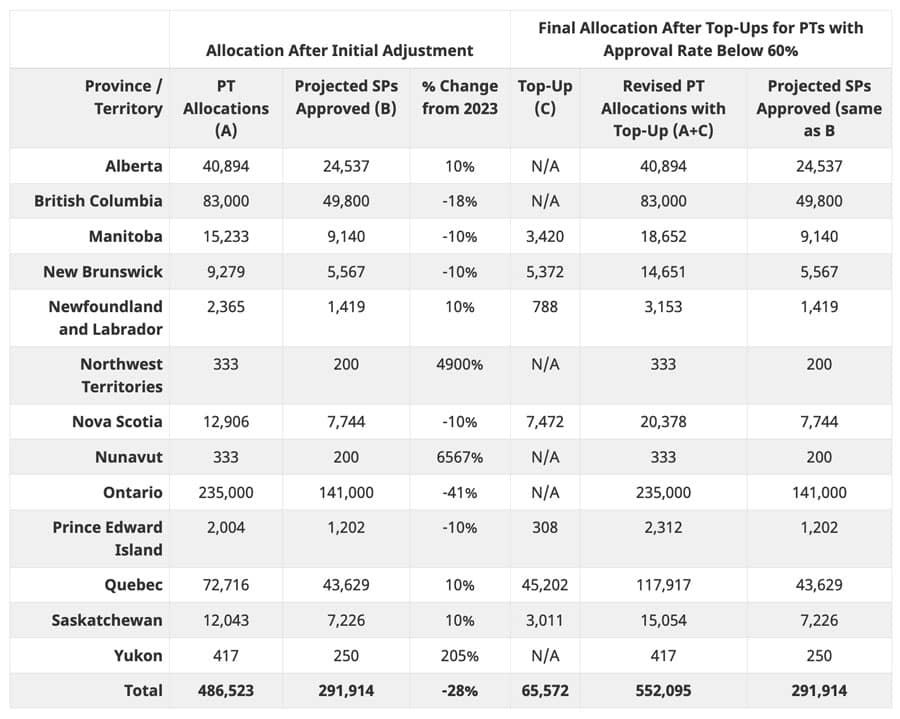Canadian immigration minister releases official cap figures and targets for 2024
- Canadian Immigration Minister Marc Miller has announced an official national cap allocation of 552,000 study permit applications for 2024, which is expected to yield 292,000 new study permits during the year for students affected by Canada’s new international enrolment cap
- The cap is designed to hold foreign enrolment in Canada at zero growth, relative to 2023, and will provide for some increased enrolment for provinces with lower enrolments, while triggering a decrease in study permits issued for other provinces, notably Ontario and British Columbia
- The target level of study permits issued for cap-affected students appears to rely on a lower approval rate for study permit applications this year – 53% – compared to the recent historical average of 60%
In many respects, the implementation of Canada’s newly established cap on international student enrolment has been shrouded in secrecy these last few months. Some of that fog fell away on 5 April when Immigration Minister Marc Miller released a detailed statement explaining how the national cap will be allocated across provinces and territories this year, along with the high-level targets that Immigration, Refugees and Citizenship Canada (IRCC) has set for new study permits for 2024.
The important background here is the two-year cap on the number of new study permits announced by IRCC in January 2024. The extent to which study permit issuances will decline, relative to 2023 levels, has been variously reported, but it seems increasingly clear that the government has a goal to hold total foreign enrolment at, or even somewhat below, 2023 levels.
As Mr Miller explains:
“The national cap is based on the amount of expiring study permits this year. This means that the number of international students coming to Canada in 2024 should be the same as the number of students whose permits expire this year. For 2024, the target is 485,000 approved study permits.”
Further:
“About 20% of students apply for an extension each year and remain in the country. Therefore, IRCC subtracted that amount (97,000) from the target of 485,000 and set aside a small buffer to allow for other variations, resulting in a revised target of 364,000 approved study permits in 2024.”
In recent years, an average of 60% of international students’ study permit applications have been approved. With that in mind, the government had earlier determined that 606,000 study permit applications could be distributed nationally in 2024. In other words, of 606,000 study permit applications submitted by international students should yield something in the neighbourhood of 364,000 approved study permits.
But then there was a subtraction from the total:
“Some international students are exempt from the cap, such as primary and secondary school students and master’s or doctoral degree students. IRCC deducted the estimated volume of these groups (140,000 based on 2023 data) from the 2024 target number of approved study permits. This resulted in a target of 236,000 approved study permits for 2024, which converts to roughly 393,000 study permit applications to be allocated.”
The Minister goes on to explain, however, that owing to various adjustments to provincial allocations, “A total of about 552,000 study permit applications have been allocated to provinces and territories under the national cap [for 2024]. These allocations are expected to yield approximately 292,000 approved study permits, representing a 28% reduction from 2023 for the groups included under the cap.”
We can see some of those adjustments, the projected increase or decrease in study permit approvals compared to 2023, and the final, official provincial or territorial allocations in the summary table below

Of note in the table above is that the total projected number of approved study permits remains at 291,914, even after the increased total allocations to provinces and territories. If, based on a total national cap allocation of about 486,000 study permit applications (as in Column A in the table), IRCC were to approve 292,000 study permits, that would amount to a 60% approval rate. This reflects the recent historical average for the approval rate otherwise referenced by IRCC in its earlier commentaries about the cap implementation.
However, the table points to an important variation here. Even as IRCC increased the national allocation of study permit applications to 552,095, it did not alter its projected volume of study permits, which remains at just under 292,000 in the final column in the table. This appears to be because (as noted in the table header), IRCC is anticipating an “approval rate below 60%”.
Minister Miller goes on to explain that:
“Many variables may influence the number of new international students who arrive in Canada in 2024, for example
- provinces and territories with room to grow may not end up using their full allocations
- approval rates may change
- in-year adjustments may be required
These results will help me make decisions on allocations for 2025.”
All that to say that it seems clear from the cap projections that IRCC is anticipating a lower approval rate for 2024, something more like 53% as opposed to the 60% benchmark. While this has not been explicitly stated by IRCC, this suggests in turn that immigration officials are expecting to actively manage approval rates down for this year.
For additional background, please see:
- “Canada announces two-year cap on new study permits”
- “Canada: Ontario’s cap implementation plan allocates nearly all study permit applications to public colleges and universities”
- “Canada’s language training sector continues to strengthen amid new immigration settings”
- “Demand for study abroad in Australia, Canada, UK already affected by new international education policies"
















